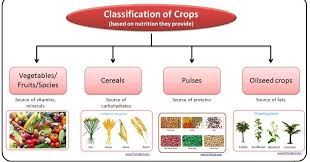Today we are going to discuss about the complete classification of crops. All crops are classified into different groups. Basically there are two major classification of crops plants which include:
- Botanical classification which is based on the morphological similarity of plants parts
- Agronomic / Economic classification is based on their uses
1) Botanical Classification of Crops
This classification of crops is based upon similarity of plant parts. Field crops belong to the spermatophyte division of the plant kingdom, in which reproduction is carried on by seeds.
Within this division the common crop plants belong to the subdivision of angiosperms, which are characterized by having their ovules enclosed in an ovary wall. The angiosperms are divided into classes, the monocotyledons and the dicotyledons.
All the grasses, which include the cereals and sugarcane, are monocotyledonous plants. The legumes and other crop plants except the grasses are classified as dicotyledons plants because the seeds have two cotyledons.
These classes are subdivided into orders, families, genera, species, subspecies, and varieties.
1i) The Grass Family
This includes about three fourth of the cultivated forage crops and all cereals crops. They are either annuals, or perennials. Grasses are almost all herbaceous plants, usually with hollow cylindrical stems closed at the nodes. The stems are made of nodes and internodes. The leaves are two-ranked and parellel-veined. The roots are fibrous.
The small greenish flowers are collected in a compact or open inflorescence, and with no terminal on the stem. The flowers are usually perfect, small and with no distinct perianth. The grain or caryopsis may be free, as in wheat, or permanently enclosed in the floral bracts as in oats.
1ii) The Legume Family
Legumes may be annuals, biennials or perennials. Leaves are alternate on the stems, stipulate with netted veins, and mostly compound. The flowers are almost always arranged in racemes as in the pea. The flowers of leguminous field crops are butterfly-like.
The irregular flowers consist of five petals, a standard, two wings, and a keel that consists of two petals that are more or less united. The calyx is normally four- or five toothed.
The fruit is a pod that contains one or several seeds. The roots system is taproot. Often the roots have an abnormal growth called nodules caused by the activities of bacterium Rhizobium.
1iii) Other Crop Families
Among the other botanical families that contain crop plants are:
- Cannabaceae (hops and hemp)
- Polygonaceae (buckwheat)
- Chenopodiaceae (sugarbeets, mangels and wormseed
- Cruciferae (mustard, rape, and kale)
- Linaceae (flax)
- Malvaceae (cotton)
- Solanaceae (potato and tobacco)
- Compositae (sunflower, safflower and Jerusalem artichoke)
Read Also: The Concept of Animal Production on Agriculture

2) Agronomic / Economic Classification of Crops
i) Cereal or Grain Crops
Cereals are grasses grown for their edible seeds, the term cereal being applied either to the grain or to the plant itself. Cereals include wheat, oats, barley, rice, maize, sorghum, millet, etc.
ii) Legumes
These include pea nuts, field beans, cowpeas, soybeans lima beans, mug beans, chickpeas, pigeon peas, broad beans and lentils. They all belong to the family Leguminosae and are grown for their edible seeds.
iii) Oil Crops
The oil crops include soyabean, peanuts (groundnuts), sunflower, safflower, sesame, castor bean, mustard, cotton seed, corn and grain sorghum, rape, flax and perilla, the seeds of which contain some useful oils.
iv) Root and Tuber Crops
These include sugar beets, carrots, sweet potatoes, yams, cassava, potatoes and cocoyam.
v) Fiber Crops
These are grown for their fiber. They include cotton, jute, kenaf, hemp, ramie and sisal.
vi) Sugar Crops
These are crops that are grown for their sweet juice from which sucrose is extracted and crystallized. They include sugarcane and sugar beet.
vii) Forage Crops
These are vegetable matters fresh or preserved that are utilized as feeds for animals. They include grasses, legumes, crucifers and other cultivated crops.
Viii) Vegetable Crops
This group include potatoes, tomatoes and onions.
ix) Rubber Crops / Latex Crops
These crops which include Para rubber, are grown for the milky sap, or latex which they produce.
x) Beverage Crops
These crops are also sources of stimulants. They include tea, coffee and cocoa.
3) Special-Purpose Classification
1) Cover Crops
These are crops planted to provide a protection to the soil against direct beating of rainfall. When crops are turned under while still green, they are termed green manure crops. Important green manure crops include alfalfa, soyabeans, cowpea, rye, and buckwheat.
2) Catch Crops
Catch crops are substitute crops planted too late for regular crops or after the regular crop have failed. Short season crops such as millet and buckwheat are often used as catch crops.
3) Soiling Crops
These are crops that are cut and fed green and may include legumes, grasses, kale,and maize.
4) Silage Crops
Silage crops are those cut and preserved in succulent condition by partial fermentation. They include corn, sorghum, forage grasses and legumes.
5) Companion Crops
These are crops that are grown with a crop such as alfalfa or red clover in order to secure a return from the land in the first year of a new seeding. Grain crops and flax are often used for this purpose.
6) Trap Crops
These are crops planted to attract certain insects or parasites. Trap crops are plowed under or destroyed once they have served their purpose.
